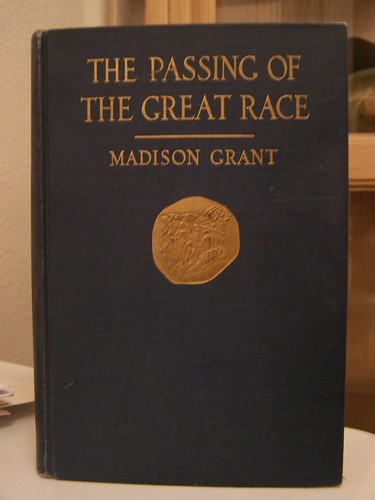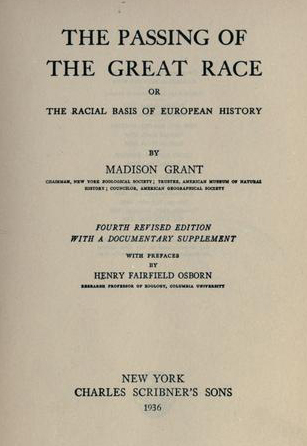
Madison Grant’s The Passing of the Great Race, published in 1916, is a classic in race studies.
It is hard to imagine that when my grandmas were little girls, The Passing became immensely popular both in the United States and in Europe. Henry Fairfield Osborn wrote in the Preface:
In the chapters relating to the racial history of Europe we enter a new and fascinating field of study, which I trust the author himself may some day expand into a longer story.
I was fascinated by Osborn’s Preface and can only ask, after a century since the book was written, where are the historians who ought to have followed Grant’s steps? By now heavy treatises, such as Gibbon’s multivolume study on the fall of Rome, but this time taking race as the basis to understand European history should have been written. But we only have Grant’s preliminary study for a racial understanding of history. Why are people of European origin sleeping so deeply?
In “Europe in Dormition” Dominique Venner wrote, “The state of ‘dormition’ is the consequence of the catastrophic excesses of the murderous, fratricidal frenzy perpetrated between 1914 and 1945. It was also the gift of the US and USSR, the two hegemonic powers resulting from the Second World War.” I would have said “between 1914 to 1947” since the Americans and the Bolsheviks perpetrated an Holocaust targeting the German people that nobody wants to discuss in the mainstream media.
While Grant was a Nordicist I believe that studying this classic may help Caucasians of both Nordish of Mediterranean ancestry to wake up. Below, a few excerpts from Osborn’s Preface (no ellipsis added):

The Passing of the Great Race, in its original form, was designed by the author to rouse his fellow Americans to the overwhelming importance of race and to the folly of the “Melting Pot” theory, even at the expense of bitter controversy. This purpose has been accomplished thoroughly, and one of the most far-reaching effects of the doctrines enunciated in this volume and in the discussions that followed its publication was the decision of the Congress of the United States to adopt discriminatory and restrictive measures against the immigration of undesirable races and peoples.
The best example of complete elimination of a dominant class is in Santo Domingo. The horrors of the black revolt were followed by the slow death of the culture of the white man. This history should be studied carefully because it gives in prophetic form the sequence of events that we may expect to find in Mexico and in parts of South America where the replacement of the higher type by the resurgent native is taking place. In the countries inhabited by a population more or less racially uniform the phenomenon of the multiplication of the inferior classes fostered and aided by the noble but fatuous philanthropy of the well-to-do everywhere appears. Nature’s laws when unchecked maintain a relatively fixed ratio between the classes, which is greatly impaired in modern society by humanitarian and charitable activities.
The late Peloponnesian War in the world at large, like the Civil War in America, has shattered the prestige of the white race and it will take several generations and perhaps wars to recover its former control, if it ever does regain it. [This preface was written in 1916] The danger is from within and not from without. Neither the black, nor the brown, nor the yellow, nor the red will conquer the white in battle. But if the valuable elements in the Nordic race mix with inferior strains or die out through race suicide, then the citadel of civilization will fall for mere lack of defenders.
One of the curious effects of democracy is the unquestionable fact that there is less freedom of the press than under autocratic forms of government. It is well-nigh impossible to publish in the American newspapers any reflection upon certain religions or races which are hysterically sensitive even when mentioned by name. The underlying idea seems to be that if publication can be suppressed the facts themselves will ultimately disappear. Abroad, conditions are fully as bad, and we have the authority of one of the most eminent anthropologists in France that the collection of anthropological measurements and data among French recruits at the outbreak of the Great War was prevented by Jewish influence, which aimed to suppress any suggestion of racial differentiation in France. In the United States also, during the war, we were unable to obtain complete measurements and data, in spite of the self-devotion of certain scientists. This failure was due to lack of time and equipment and not to racial influences, but in the near future we may confidently expect in this country strenuous opposition to any public discussion of race as such.
The days of the Civil War and the provincial sentimentalism which governed or misgoverned our public opinion are past, and this generation must completely repudiate the proud boast of our fathers that they acknowledged no distinction in “race, creed, or color,” or else the native American must turn the page of history and write:
FINIS AMERICA
3 replies on “Preface”
Wow. Just wow.
Incredible! Was this really published in 1916? Why is this prophetic thinker almost forgotten nowadays?
Correction. Osborn wrote two prefaces, the first one in July 1916 and the second in December 1917. I mixed the two of them in the above excrept.